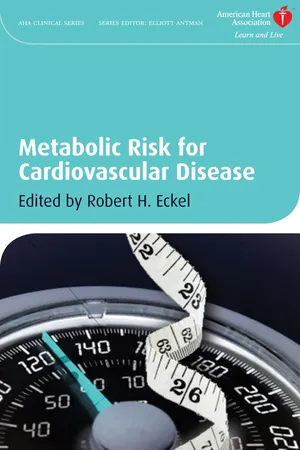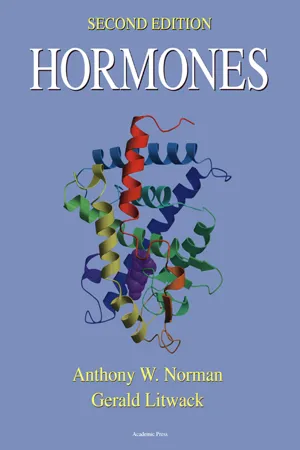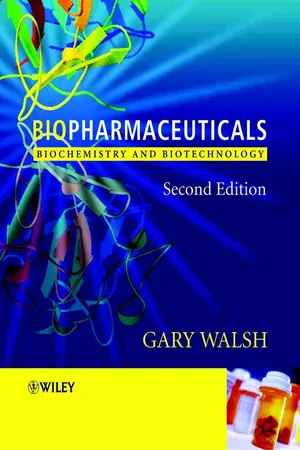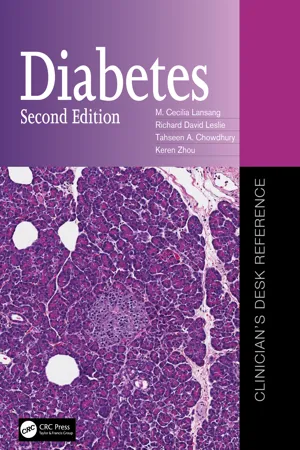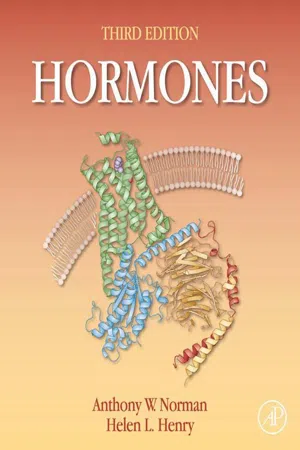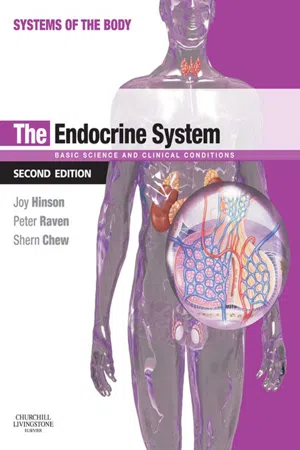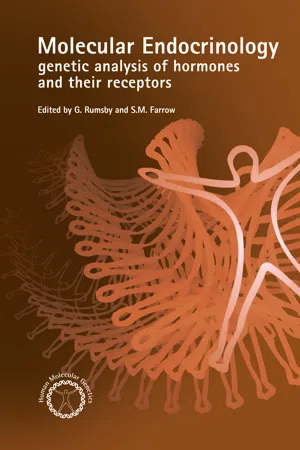Biological Sciences
Insulin
Insulin is a hormone produced by the pancreas that plays a key role in regulating blood sugar levels. It helps cells in the body absorb glucose from the bloodstream to use as energy or store for later use. Insulin also helps to lower blood sugar levels by signaling the liver to store excess glucose. Its proper functioning is crucial for maintaining overall health and preventing conditions like diabetes.
Written by Perlego with AI-assistance
Related key terms
Related key terms
1 of 4
Related key terms
1 of 3
8 Key excerpts on "Insulin"
- eBook - ePub
- Robert H. Eckel(Author)
- 2011(Publication Date)
- Wiley-Blackwell(Publisher)
Chapter 1 Insulin action and beta-cell function: role in metabolic regulation Kristina M. Utzschneider and Steven E. Kahn Regulation of fuel utilization in health and diseaseThe normal processing and utilization of fuels is tightly regulated by hormonal, neural, and intracellular mechanisms so that carbohydrates, proteins, and fats supply energy to the brain, muscles, and other tissues, and excess fuel is stored efficiently for use during periods of fasting or increased energy needs. Two key players in the balance of hormones regulating these processes are Insulin and glucagon.Insulin is secreted by the islet beta-cell in response to glucose, amino acids, peptides, and fatty acids and then promotes tissue uptake of glucose and glyco-gen synthesis. Insulin also acts on lipid metabolism by promoting enzymes involved in de novo lipogenesis, while suppressing those enzymes involved in lipid oxidation and lipolysis, resulting in a decrease in circulating free fatty acids (FFAs). The net result is a shift towards utilization of glucose as the primary fuel. Insulin’s effects are mainly anabolic as Insulin levels increase when nutrient availability is high. During times when Insulin levels are low, such as during fasting, these processes reverse and fuel selection shifts to preferentially utilize fat. Insulin also acts centrally in the hypothalamus as a satiety signal by interacting with neural centers that regulate food intake.In contrast to Insulin, the hormone glucagon, which is secreted by the islet alpha-cell, acts as a catabolic hormone, stimulating production of glucose via glycogenolysis and gluconeogenesis, primarily in response to hypoglycemia. Glucagon is also important in the regulation of basal and postprandial glucose levels, with the balance of this hormone with Insulin being important. Thus, when Insulin levels rise, as occurs after nutrient ingestion, glucagon levels will normally decrease. - eBook - ePub
- Anthony W. Norman, Gerald Litwack(Authors)
- 1997(Publication Date)
- Academic Press(Publisher)
These can include (1) the intestinal absorption and concomitant systemic transport to storage depots (liver, muscle, and/or adipose tissue) of foodstuffs (e.g., carbohydrates, proteins, fat); (2) muscular activity; (3) thermogenesis and response to environmental extremes of heat and cold; (4) starvation; (5) pregnancy/lactation; and (6) disease or injury states. The endocrine gland largely responsible for the maintenance of blood glucose levels and the proper cellular uptake and exchange of “fuel metabolites” is the pancreas. The principal hormones secreted by the pancreas are Insulin and glucagon. In addition, the pancreas secretes a number of other peptide hormones (see Table 7-6). Table 7-6 Hormones and Proteins Secreted by the Pancreas a IAPP is structurally homologous to calcitonin gene-related peptide (CGRP); see Figure 9-4. b The chromogranins A, B, and C are a family of closely related acidic proteins that are produced by many neuroendocrine cells. Chromogranins A are produced by pancreatic α, β, and F cells of the pancreatic islet. c The B cells also secrete small quantities of procathepsin B, carboxypeptidase H, endopeptidases I and II, and peptidylglycan α- amidating monooxygenase. Insulin is a pluripotent hormone in that it has a wide sphere of influence; directly or indirectly it affects virtually every organ and tissue in the body. The main function of Insulin is to stimulate anabolic reactions for carbohydrates, proteins, and fats, all of which will have the metabolic consequence of producing a lowered blood glucose level. Glucagon can be thought of as an indirect antagonist of Insulin. Glucagon stimulates catabolic reactions that ultimately lead to an elevation in blood glucose levels - eBook - ePub
Biopharmaceuticals
Biochemistry and Biotechnology
- Gary Walsh(Author)
- 2013(Publication Date)
- Wiley-Blackwell(Publisher)
in vitro studies and at high Insulin concentrations. Some of these mitogenic effects are likely mediated via the Insulin-like growth factor 1 (1GF-1) receptor and their physiological relevance is questionable.Although many cells in the body express the Insulin receptor, its most important targets are skeletal muscle fibres, hepatocytes and adipocytes, where it often antagonizes the effects of glucagon (Table 8.1 ). The most potent known stimulus of pancreatic Insulin release is an increase in blood glucose levels, often occurring after meal times. Insulin orchestrates a suitable metabolic response to the absorption of glucose and other nutrients in a number of ways:Table 8.1. Some metabolic effects of Insulin. These effects are generally countered by other hormones (glucagon and, in some cases, adrenaline). Hence, the overall effect noted often reflects the relative rates of these hormones present in the plasma- it stimulates glucose transport (and transport of amino acids, K+ ions and other nutrients) into cells, thus reducing their blood concentration;
- it stimulates (or helps to stimulate) intracellular biosynthetic (anabolic) pathways, such as glycogen synthesis (Table 8.1 ), which helps to convert the nutrients into a storage form in the cells;
- it inhibits (or helps to inhibit) catabolic pathways, such as glycogenolysis;
- it stimulates protein and DNA synthesis (which underlies Insulin’s growth-promoting activity).
In general, Insulin achieves such metabolic control by inducing the dephosphorylation of several key regulatory enzymes in mainline catabolic or anabolic pathways. This inhibits the former and stimulates the latter pathway types. These effects are often opposed by other hormones, notably glucagon and adrenaline. Thus, when blood glucose concentrations decrease (e.g. during fasting), Insulin levels decrease and the (largely catabolic) effects of glucagon become more prominent. Insulin also induces its characteristic effects by altering the level of transcription of various genes, many of which code for metabolic enzymes. Another gene upregulated by Insulin is that of the integral membrane glucose transporter. - eBook - ePub
- Joy P. Hinson Raven, Peter Raven, Shern L. Chew, Stephen H. Hughes(Authors)
- 2022(Publication Date)
- Elsevier(Publisher)
Chapter 11: Insulin and the regulation of plasma glucose
Chapter objectivesAfter studying this chapter you should be able to:1. Explain how plasma glucose concentrations are maintained within a normal range.2. Explain the mechanisms controlling the secretion of Insulin.3. Describe the actions of Insulin.4. Explain the consequences of a deficiency in Insulin production or action.5. Describe the main treatment options for type 1 and type 2 diabetes mellitus.6. Describe the ‘metabolic syndrome’.Introduction
The brain uses glucose, its main energy source, at a much faster rate than does any other tissue in the body (Fig. 11.1 ). It is perhaps surprising, therefore, that the brain does not keep significant stores of glucose. Instead, the brain relies on obtaining a constant supply of glucose from the blood. As a result, the brain is extremely sensitive to a fall in blood glucose levels. Meanwhile, a sustained high level of blood glucose causes problems due to the increased osmolarity of blood; ultimately, this leads to tissue damage as a result of inappropriate glycosylation in body tissues. Circulating concentrations of glucose are therefore maintained within relatively tight limits. This requires a complex system of control because the plasma glucose levels can rise rapidly after a meal, but could also become very low during periods of fasting.There are several hormones that act to increase the circulating glucose concentrations, but the major hormone involved in lowering the blood glucose load is Insulin, a hormone secreted by the pancreas. A deficiency of either Insulin production or effectiveness results in a condition known as diabetes mellitus. There are two principal forms of this disorder: type 1, which is Insulin-dependent (IDDM) and results from loss of Insulin production; and type 2 or ‘non-Insulin-dependent’ (NIDDM), which is a condition of Insulin resistance (Table 11.1 ).Fig. 11.1 - eBook - ePub
Diabetes
Clinician's Desk Reference
- M. Cecilia Lansang, Richard David Leslie, Tahseen A. Chowdhury, Keren Zhou(Authors)
- 2022(Publication Date)
- CRC Press(Publisher)
- Overactivity of glucose-6-phosphatase contributes to the increased and relatively Insulin-insensitive hepatic glucose production in type 2 diabetes.
- Metformin and the thiazolidinediones (see Chapter 14 ) appear to reduce the activity of this enzyme, although it is not clear whether their effects are direct or mediated through some other upstream action.
The role and regulation of Insulin
- Insulin is the predominant hormone regulating blood glucose concentration. It is the key hormone involved in both the storage and the controlled release of energy.
- Diabetes occurs as a result of a failure of Insulin production and secretion (Insulin deficiency) and/or the loss of response to Insulin (Insulin resistance).
- Insulin is coded for by genes on chromosome 11 and is synthesized and secreted by the β cells of the islets of Langerhans in the pancreas. Complex cellular events trigger the release of Insulin from the secretory granules of these cells.
Hormones called incretins are peptides secreted by the gut in response to a meal and stimulate the secretion of Insulin. Of these, glucagon-like peptide-1 (GLP-1, produced by the lower intestine) and glucose-dependent Insulinotropic polypeptide (GIP, produced by the upper intestine) are the better-studied incretins.- After secretion, Insulin enters the portal circulation, which takes it to the liver, a prime target organ of Insulin action.
- Although Insulin is the major regulator of intermediary metabolism, its actions are modified by other hormones, e.g. glucagon, epinephrine (adrenalin), cortisol, and growth hormone. Such counter-regulatory hormones increase glucose production from the liver and, for a given level of Insulin, reduce utilization of glucose in adipose tissue and muscle.
- eBook - ePub
- Anthony W. Norman, Helen L. Henry(Authors)
- 2014(Publication Date)
- Academic Press(Publisher)
These include the following: (i) relaxin, a polypeptide hormone from the corpus luteum that is responsible for the dilation of the symphysis pubis prior to parturition; (ii) Insulin-like growth factors (IGFs) I or II; and (iii) nerve growth factor (NGF). 5 Insulin Receptor Insulin is the chief hormone controlling intermediary metabolism. It affects virtually every tissue in the body, but principally liver, muscle, and adipose tissue. Its short-term effects are to reduce blood glucose and to conserve body fuel supplies. There are also a number of effects of Insulin on the regulation of gene transcription and cell replication. The number of Insulin receptors in Insulin target cells ranges from less than 100 to more than 200,000 per cell. The highest concentrations of the Insulin receptor are found in hepatocytes and adipocytes. The upper A panel of Figure 6-6 presents a schematic of the general structure of a single Insulin receptor comprised of two α and two β subunits that are interlinked by three disulfide bonds, thus creating two ligand binding domains for Insulin on one copy of the receptor. The second half of the schematic of Figure 6-6B provides a sample of the signal transduction pathways that can be initiated and fully activated in a cell by the binding of Insulin to its receptor. In this model, four kinds of biological responses are diagrammed; they are (i) vascular constriction, (ii) vascular relaxation, (iii) stimulation of glucose uptake followed by glycogen synthesis in the liver, muscle, and adipose tissues, and (iv) translocation of glucose transporters (GLUT4) to the cell’s plasma membrane - eBook - ePub
The Endocrine System
Systems of the Body Series
- Joy P. Hinson, Peter Raven, Shern L. Chew(Authors)
- 2013(Publication Date)
- Churchill Livingstone(Publisher)
After binding of Insulin to its receptor, the hormone–receptor complex moves through the plasma membrane of the cell and collects in a specialized region of the cell membrane where groups of receptors are taken into the cell by the process of endocytosis. The receptors are processed in lysosomes where they are either degraded or recycled back to the cell membrane. It has been estimated that the half-life of an Insulin receptor at the cell membrane is around seven hours.In Insulin resistance (see type 2 diabetes mellitus below) it appears that there is impaired signalling from the Insulin receptor, rather than a defect in the receptor itself. Instead of tyrosine phosphorylation it appears that increased phosphorylation of serine residues on IRS diminishes its ability to signal through PI3K.Glucagon and other hormones that act to raise blood glucose levels
Although Insulin is the only hormone responsible for preventing blood glucose levels from rising too high, several hormones are involved in preventing blood glucose from falling too low. This ‘multifactorial’ regulation clearly reflects the importance of preventing blood glucose from becoming too low.Classically, glucagon is the hormone that opposes the effects of Insulin, and acts to raise blood glucose levels when they fall, thus maintaining blood glucose between meals and in the fasting state (Fig. 11.2 ). In reality, however, several hormones act together to respond to hypoglycaemia; the maintenance of fasting glucose is complex and also involves growth hormone (see Ch. 4 ), catecholamines and glucocorticoids (see Chs. 5 and 6 ). When there are disorders of these hormonal systems, such as excess growth hormone or cortisol secretion, hyperglycaemia and impaired glucose tolerance are often seen.Glucagon is secreted by the α cells of the pancreatic islet as a 29-amino-acid peptide. Its release is inhibited by glucose and so it is secreted in response to low glucose levels in the α cells. The effects of glucagon are mainly on the liver, where it increases the rate of glycogen breakdown (glycogenolysis) and stimulates pathways of glucose formation from amino acids (gluconeogenesis). The net effect of these actions is to raise blood glucose levels. Glucagon also acts on adipose tissue to stimulate lipolysis, the breakdown of fat stores, producing increased plasma free fatty acid concentrations. In Insulin deficiency (see below) the actions of glucagon contribute significantly to the hyperglycaemia and ketosis. - eBook - ePub
Molecular Endocrinology
Genetic Analysis of Hormones and their Receptors
- Gill Rumsby, Dr Sheelagh Farrow(Authors)
- 2020(Publication Date)
- Garland Science(Publisher)
et al., 1996; Moller and Flier, 1991). In a small minority of cases, distinct genetic factors have been identified which cause Insulin-resistant conditions linked with NIDDM. These experiments of nature have often provided important insights into the mechanisms by which glucose metabolism is regulated.This chapter describes recent advances in our understanding of how whole body glucose homeostasis is maintained including the molecular mechanisms by which glucose regulates Insulin secretion and the mechanisms by which Insulin and glucagon regulate glucose metabolism in liver, muscle and adipose tissue. How derangements in these processes contribute to diabetes is also discussed.5.2 The role of the endocrine pancreas
The endocrine pancreas is made up of four major cell types (α, β, γ, δ) and the regulated secretion of peptide hormones from these cells provides the main mechanism by which the body achieves glucose homeostasis. The major role of the α cells is to secrete glucagon in response to low blood glucose levels while that of the β cells is to secrete Insulin in response to rising glucose. The δ cells produce somatostatin which inhibits secretion of many peptide hormones including Insulin and glucagon. As somatostatin secretion is increased in response to glucagon it is likely to play a physiologically relevant role in regulating hormone secretion in the pancreas (Unger and Orci, 1981).5.2.1 Glucagon expression and secretion in the a cells
Glucagon is a 29-amino-acid peptide hormone with a high degree of homology to vasoactive intestinal protein, gastric inhibitory protein and secretin (Lefebvre, 1995; Philippe, 1991). The mammalian glucagon gene encodes for a 180 amino-acid pre-proglucagon molecule which is expressed in pancreatic a cells as well as in other specific locations such as the L cells of the gut. Complete processing of preproglucagon yields the four related peptide hormones glucagon, glucagon-related pancreatic peptide (GRPP) and two isoforms of glucagon-like peptide (GLP-1 and GLP-2). However, differential processing mechanisms exist for preproglucagon in different tissues. Therefore, in the a cells of the pancreas only glucagon and small amounts of GLP-1 are produced while the L-cells of the gut do not produce glucagon. Glucagon gene expression is decreased by hyperInsulinaemia and increased by hypoInsulinaemia (Philippe, 1991). This has physiological importance in human type-1 and type-2 diabetics, where the pancreatic a cell is still fully functional. In these subjects increased rates of glucagon production are observed which can be suppressed by administration of counteracting doses of Insulin (Unger and Orci, 1981). However, the intracellular mechanisms by which glucose and Insulin levels regulate glucagon secretion are still poorly understood (Lefebvre, 1995).
Index pages curate the most relevant extracts from our library of academic textbooks. They’ve been created using an in-house natural language model (NLM), each adding context and meaning to key research topics.
Explore more topic indexes
Explore more topic indexes
1 of 6
Explore more topic indexes
1 of 4
